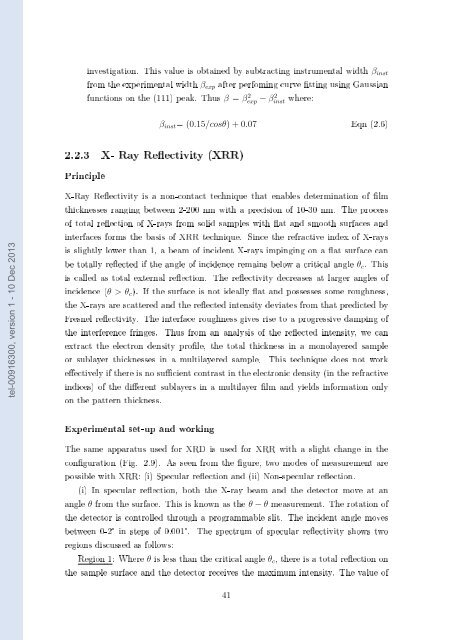Films minces à base de Si nanostructuré pour des cellules ...
Films minces à base de Si nanostructuré pour des cellules ...
Films minces à base de Si nanostructuré pour des cellules ...
You also want an ePaper? Increase the reach of your titles
YUMPU automatically turns print PDFs into web optimized ePapers that Google loves.
investigation. This value is obtained by subtracting instrumental width β inst<br />
from the experimental width β exp after perfoming curve tting using Gaussian<br />
functions on the (111) peak. Thus β = β 2 exp − β 2 inst where:<br />
β inst = (0.15/cosθ) + 0.07 Eqn (2.6)<br />
2.2.3 X- Ray Reectivity (XRR)<br />
Principle<br />
tel-00916300, version 1 - 10 Dec 2013<br />
X-Ray Reectivity is a non-contact technique that enables <strong>de</strong>termination of lm<br />
thicknesses ranging between 2-200 nm with a precision of 10-30 nm. The process<br />
of total reection of X-rays from solid samples with at and smooth surfaces and<br />
interfaces forms the basis of XRR technique. <strong>Si</strong>nce the refractive in<strong>de</strong>x of X-rays<br />
is slightly lower than 1, a beam of inci<strong>de</strong>nt X-rays impinging on a at surface can<br />
be totally reected if the angle of inci<strong>de</strong>nce remains below a critical angle θ c . This<br />
is called as total external reection. The reectivity <strong>de</strong>creases at larger angles of<br />
inci<strong>de</strong>nce (θ > θ c ). If the surface is not i<strong>de</strong>ally at and possesses some roughness,<br />
the X-rays are scattered and the reected intensity <strong>de</strong>viates from that predicted by<br />
Fresnel reectivity. The interface roughness gives rise to a progressive damping of<br />
the interference fringes. Thus from an analysis of the reected intensity, we can<br />
extract the electron <strong>de</strong>nsity prole, the total thickness in a monolayered sample<br />
or sublayer thicknesses in a multilayered sample. This technique does not work<br />
eectively if there is no sucient contrast in the electronic <strong>de</strong>nsity (in the refractive<br />
indices) of the dierent sublayers in a multilayer lm and yields information only<br />
on the pattern thickness.<br />
Experimental set-up and working<br />
The same apparatus used for XRD is used for XRR with a slight change in the<br />
conguration (Fig. 2.9). As seen from the gure, two mo<strong>de</strong>s of measurement are<br />
possible with XRR: (i) Specular reection and (ii) Non-specular reection.<br />
(i) In specular reection, both the X-ray beam and the <strong>de</strong>tector move at an<br />
angle θ from the surface. This is known as the θ − θ measurement. The rotation of<br />
the <strong>de</strong>tector is controlled through a programmable slit. The inci<strong>de</strong>nt angle moves<br />
between 0-2° in steps of 0.001°. The spectrum of specular reectivity shows two<br />
regions discussed as follows:<br />
Region 1: Where θ is less than the critical angle θ c , there is a total reection on<br />
the sample surface and the <strong>de</strong>tector receives the maximum intensity. The value of<br />
41
















